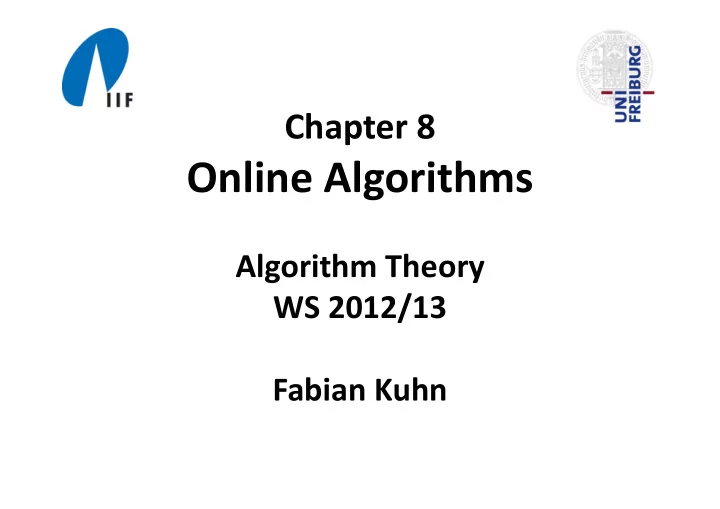

Chapter 8 Online Algorithms Algorithm Theory WS 2012/13 Fabian Kuhn
Self ‐ Adjusting Lists • Linked lists are often inefficient – Cost of accessing an item at position � is linear in � • But, linked lists are extremely simple – And therefore nevertheless interesting • Can we at least improve the behavior of linked lists? • In practical applications, not all items are accessed equally often and not equally distributed over time – The same items might be used several times over a short period of time • Idea: rearrange list after accesses to optimize the structure for future accesses • Problem: We don’t know the future accesses – The list rearrangement problems is an online problem! Algorithm Theory, WS 2012/13 Fabian Kuhn 2
Model • Only find operations (i.e., access some item) – Let’s ignore insert and delete operations – Results can be generalized to cover insertions and deletions Cost Model: • Accessing item at position � costs � • The only operation allowed for rearranging the list is swapping two adjacent list items • Swapping any two adjacent items costs 1 Algorithm Theory, WS 2012/13 Fabian Kuhn 3
Rearranging The List Frequency Count (FC): • For each item keep a count of how many times it was accessed • Keep items in non ‐ increasing order of these counts • After accessing an item, increase its count and move it forward past items with smaller count Move ‐ To ‐ Front (MTF): • Whenever an item is accessed, move it all the way to the front Transpose (TR): • After accessing an item, swap it with its predecessor Algorithm Theory, WS 2012/13 Fabian Kuhn 4
Cost Cost when accessing item at position � : • Frequency Count (FC): between � and 2� � 1 • Move ‐ To ‐ Front (MTF): 2� � 1 • Transpose (TR): � � 1 Random Accesses: • If each item � has an access probability � � and the items are accessed independently at random using these probabilities, FC and TR are asymptotically optimal Real access patterns are not random, TR usually behaves badly and the much simpler MTF often beats FC Algorithm Theory, WS 2012/13 Fabian Kuhn 5
Move ‐ To ‐ Front • We will see that MTF is competitive • To analyze MTF we need competitive analysis and amortized analysis Operation � : • Assume, the operation accesses item � at position � • � � : actual cost of the MTF algorithm � � � �� � � • � � : amortized cost of the MTF algorithm ∗ : actual cost of an optimal offline strategy • � � – Let’s call the optimal offline strategy OPT Algorithm Theory, WS 2012/13 Fabian Kuhn 6
Potential Function Potential Function � � : • Twice the number of inversions between the lists of MTF and OPT after the first � operations • Measure for the difference between the lists after � operations • Inversion: pair of items � and � such that � precedes � in one list and � precedes � in the other list Initially, the two lists are identical: � � � � For all � , it holds that � � � � � � ⋅ � � � ��� � �� To show that MTF is � ‐ competitive, we need to show that ∗ ∀�: � � � � � � � � � � ��� � � ⋅ � � Algorithm Theory, WS 2012/13 Fabian Kuhn 7
Competitive Analysis Theorem: MTF is � ‐ competitive . Proof: ∗ • Need that � � � � � � Φ � � Φ ��� � 4� � • Position of � in list of OPT: � ∗ • Number of swaps of OPT: � ∗ • In MTF list, position of � is changed w.r.t. to the � � 1 preceding items (nothing else is changed) • For each of these items, either an inversion is created or one is destroyed (before the � ∗ swaps of OPT) • Number of new inversions (before OPT’s swaps) � � ∗ � 1 : – Before op. � , only � ∗ � 1 items are before � in OPT’s list – With all other items, � is ordered the same as in OPT’s list after moving it to the front Algorithm Theory, WS 2012/13 Fabian Kuhn 8
Competitive Analysis Theorem: MTF is � ‐ competitive . Proof: ∗ • Need that � � � � � � Φ � � Φ ��� � 4� � ∗ � � ∗ � � ∗ • � � � 2� � 1 , � � • Number of inversions created: � � ∗ � 1 � � ∗ • Number of inversions destroyed: � � � � ∗ Algorithm Theory, WS 2012/13 Fabian Kuhn 9
Recommend
More recommend